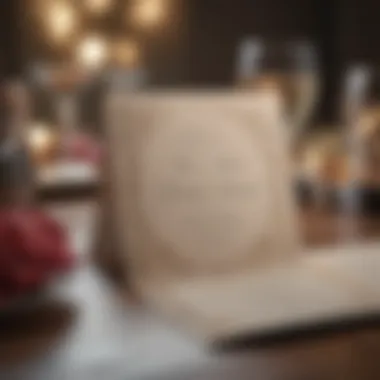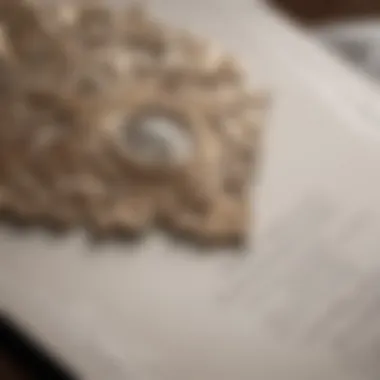Understanding the Cost of Wedding Invitations


Intro
Planning a wedding involves many financial considerations, one of the most essential being the cost of wedding invitations. While it may seem like a small component of the overall budget, invitations set the tone for the entire event. Understanding their costs is critical for effective budget management. This section explores various styles, types, and the associated expenses of invitations, allowing couples to make informed decisions. Couples should consider not just the base price, but also the extras that can impact the final cost of their invitations.
Costs can vary significantly depending on the design, material, and printing methods chosen. It is crucial to approach the subject with a clear understanding of potential expenses and to consider strategies to manage these costs effectively.
In this article, we will walk through the financial aspects surrounding wedding invitations. This includes exploring various styles and available options, discussing additional expenses couples might encounter, and providing insights on budget management. Overall, our goal is to offer a detailed guide that empowers couples to navigate the financial terrain of wedding invitations with confidence.
Overview of Wedding Invitation Costs
Determining the costs associated with wedding invitations requires a multifaceted approach. Couples often begin with a rough estimate based on their preferences.
- Variable Elements Impacting Cost:
- Additional Components:
- Design complexity: Unique designs may incur higher prices.
- Quantity: More invitations typically mean a lower per-unit cost.
- Printing techniques: Digital printing may be cheaper than letterpress printing.
- RSVP cards and envelopes can add to overall costs.
- Wax seals or special embellishments result in further expenses.
Understanding these factors is vital for managing your budget effectively.
Comparative Analysis of Invitation Types
Paper Invitations
Paper invitations are traditional and can be customized in various ways, from colors to font choices. The price range can be extensive, making it necessary to compare options.
Digital Invitations
Digital invitations offer a more affordable alternative. They provide an environmentally friendly option. While they may lack the tactile quality of paper, their costs are often significantly lower.
DIY Invitations
Creating DIY invitations allows couples to save money while incorporating personal touches. The overall cost can depend on the materials chosen. However, this demands an investment of time and effort.
Expert Insights and Recommendations
Industry Expert Opinions
Wedding planners often recommend setting aside a specified percentage of the total budget for invitations. This percentage typically falls between 3% to 5%.
Data-Backed Recommendations
Research indicates that couples who plan their invitations early tend to save more. Early planning allows for better deals and discounts.
Strategies for Financial Decisions
How to Choose the Right Invitation
A thoughtful assessment of styles and personal options can help in selecting the right invitation. Consideration of both aesthetic appeal and cost is crucial in this decision.
Maximizing Budget Potential
- Bundle offers: Look for vendors that offer packages which could save on printing and postage costs.
- Print at home: If creating DIY invitations, consider printing them at home to cut down on expenses.
Resources for Additional Learning
To further explore the topic and expand your knowledge about wedding invitation costs, consider utilizing the following resources:
- Wedding Planning Forums: Engage in discussions on platforms like reddit.com for insights from other couples.
- Budgeting Tools: Use online calculators to help visualize costs and adjust your budget accordingly.
- Educational Material: Read articles on sites such as britannica.com for information on wedding invitation trends and costs.


Prelims to Wedding Invitations
Understanding wedding invitations is crucial for any couple planning their big day. These pieces of art serve multifaceted purposes not only as a means of communication but also as a representation of the wedding's theme and tone. Hence, delving into this topic can help couples appreciate the role that invitations play in their overall wedding plan. The experience of receiving an invitation often creates an emotional connection to the event long before it occurs. Therefore, by fully grasping the significance of invitations, couples are better equipped to make informed decisions that resonate with their vision.
Purpose of Wedding Invitations
The primary purpose of wedding invitations is straightforward: they inform guests about the event details. This typically includes the who, what, when, and where of the celebration. However, wedding invitations are more than just information carriers. They set the tone for the event and showcase the couple's unique style. An elegant, formal invitation may signal a black-tie occasion, while a quirky, casual card may hint at a relaxed beach ceremony. Moreover, invitations can also serve as a keepsake, a memento that guests may save as a reminder of the occasion.
In addition, sending wedding invitations in a timely manner helps manage guest expectations. It enables them to plan their schedules, accommodations, and travel arrangements. Clear and concise information prevents misunderstandings which can lead to added stress on both ends.
The Role of Invitations in Wedding Planning
Invitations play a pivotal role in the wedding planning process. They not only announce the wedding but also bridge communication between the couple and their guests. The selection process for invitations can encourage couples to think critically about logistics such as the guest list, venue, and overall budget. Choosing a design, deciding on an invitation style, and determining the quantity needed often force couples to finalize details of their wedding plan.
Furthermore, invitations can impact the budget. Couples must consider the cost of design, materials, and printing. It's common for couples to overlook these expenses, which can lead to financial strain. A well-structured invitation plan enables the couple to allocate resources wisely, ensuring they stay within their budget without sacrificing quality or personal expression.
In summary, wedding invitations are more than just paper. They encapsulate the joy and meaning behind the celebration while aiding in the organization and planning process. Awareness of their role can directly influence the overall coherence and success of the wedding.
Factors Influencing Wedding Invitation Costs
Understanding the factors that influence wedding invitation costs is crucial for couples navigating their wedding budgets. Each element contributes in its own way to the overall pricing, offering areas where savings may be identified or where investments yield better quality and impact. Gettng a handle on these specifics can lead to more informed financial decisions and effective allocation of resources in the wedding planning process.
Design Complexity
The complexity of the design directly correlates with the cost of wedding invitations. A minimalist invitation often costs less than one adorned with intricate artwork or elaborate layouts. Factors such as the number of colors used, layering of materials, and the artwork's intricacy can increase the time and skill needed to create the invitations. Higher design complexity typically translates to higher prices because it requires specialized skills or software, or even artistic collaboration.
Material Selection
Material plays a significant role in establishing the price range of invitations. Options like standard cardstock are usually less expensive, while specialty papers, such as handmade or textured varieties, can elevate the cost considerably. Using eco-friendly materials or unique finishes, like foil stamping or letterpress, will also affect the budget. Couples must weigh their material choices against their budget and the overall aesthetic they wish to achieve.
Printing Techniques
Different printing techniques offer distinct appearances and costs. For instance, digital printing is generally more cost-effective and quicker, while methods like offset printing can be more labor-intensive and costly. Specialty printing options, including embossing and thermography, can also increase expenses. Couples should determine their priorities, whether they prefer a unique presentation or efficiency in production, as each method impacts the invitation's final cost.
Quantity of Invitations
The quantity of invitations required typically influences total costs. Many printing companies offer discounts based on volume, so ordering in bulk may reduce the cost per invitation significantly. Couples should consider their guest list size and plan appropriately. It is vital to account for extras like save-the-dates and invitations for future events. Rounding up on the quantity can also account for last-minute additions to the guest list or misprints.
Customization and Personalization
Customization adds a unique touch to wedding invitations but can also add significant costs. Personalized elements, such as guest names and tailored messages, require more work during the design and printing stages. These factors can increase both labor and material expenses. Off-the-shelf designs may be more budget-friendly, but they lack the personal flair that custom options provide. Couples need to balance budget constraints with the desire for personalized elements that reflect their individuality.
Average Costs of Wedding Invitations
Understanding the average costs of wedding invitations is essential for couples planning their special day. Wedding invitations serve as the formal announcement of your event, making them crucial for setting the tone and gathering your guests. This section will explore various elements that contribute to the costs associated with different styles and types of invitations.
The Benefits of Knowing Average Costs
Recognizing what to expect financially helps in avoiding overspending. Being informed allows couples to make choices that fit within their overall wedding budget. Understanding the average costs can also pave the way for comparing products and services effectively, ensuring the invitations reflect both personal style and financial reality.
Basic Invitation Sets
Basic invitation sets usually range from $1 to $5 per invite. These sets typically include a simple card with essential details like the date, time, and location of the wedding. Many online retailers, such as Vistaprint and Minted, offer these basic options at competitive prices, often providing bulk discounts.
When selecting basic invitations, it’s important to note that the cost might often reflect the quality of paper and printing techniques used. Reducing costs does not mean compromising on style; simpler designs can still look elegant without extravagant expenditures. This approach is popular with budget-conscious couples who still want to create lasting impressions without stretching their finances.
Mid-Range Options
The cost for mid-range wedding invitations generally lies between $5 and $15 per piece. These invitations often feature more intricate designs, better quality materials, and enhanced printing techniques. Options like foil stamping, letterpress, or unique folds can elevate the aesthetic appeal of mid-range invites.
Couples looking at mid-range options might want to consider additional elements that can increase costs—such as matching RSVP cards, reception cards, or intricate envelopes. It’s also possible to negotiate with local designers who can provide custom designs at reasonable rates.


Luxury and Custom Designs
Luxury wedding invitations can exceed $15 per invite and go as high as $30 or more, depending on design complexity and exclusivity. Custom designs crafted by notable designers or handmade invitations are examples of luxury options. Couples often choose these styles for their weddings to reflect a unique personal touch.
In addition to the high-quality materials used, luxury invitations typically incorporate special techniques like embossing or custom illustrations. It's advisable for couples to plan a thorough budget to accommodate these expenses, as the financial commitment for these exquisite designs can quickly add up.
"Investing in high-quality wedding invitations can set a positive tone for the entire wedding experience, making guests feel valued from the moment they receive their invite."
The End
In summarizing average costs, couples should assess their needs and priorities surrounding wedding invitations. Whether opting for basic, mid-range, or luxury designs, the average costs help aid in making more informed financial decisions, ensuring that the process remains enjoyable and aligned with their vision for the big day.
Additional Costs Associated with Invitations
When planning a wedding, it's crucial to recognize that the costs of invitations often extend beyond the price of the design itself. This section looks into the various additional expenses that couples face and underscores the significance of including these costs in the overall wedding budget.
Envelopes and Labels
Envelopes are not merely a practical necessity; they play a fundamental role in the presentation of wedding invitations. The cost of envelopes can vary widely based on style, size, and material. For instance, plain white envelopes will generally be cheaper than custom printed or colored options. Inline with invitations, couples should consider coordinating the envelope design with their invitation theme. Labels also incur additional costs, particularly if couples opt for personalized options. When budgeting, always factor in the costs of envelopes and labels, including any decorative elements, as these can increase the total expenditure significantly.
Postage Prices
It’s often overlooked that the postage required to send out invitations can become a considerable part of the overall budget. In the U.S., standard postage for a letter typically starts at seventy-eight cents for first-class mail. However, heavier invitations or those that exceed the size regulations may require additional postage, potentially doubling the initial cost. Couples should calculate the total weight and dimensions of their invites during planning to avoid surprising expenses. Furthermore, tracking options and return postage for RSVP can also be added cost considerations, further impacting the budget.
Save-the-Dates and Thank You Cards
Additional cards, such as save-the-dates and thank you cards, are often essential elements in wedding planning. Save-the-date cards generally cost less than formal invitations, but they still represent an extra expense worth noting in the budget. The costs vary depending on design and quantity, just like the invitations. Thank you cards are similarly important and should not be neglected in financial planning. Couples should allocate funds for both the design and printing of these items to avoid financial strain later. Properly accounting for these extra items ensures the wedding budget remains under control.
Important Consideration: Always evaluate the total costs when planning for wedding invitations to prevent unexpected financial burdens.
Budgeting for Wedding Invitations
Budgeting for wedding invitations is an essential part of the overall wedding planning process. It ensures that couples can create a beautiful and meaningful invitation that aligns with their financial plan. With an array of options available in terms of design, material, and printing techniques, setting a clear budget helps to make informed decisions, preventing overspending in other areas of the wedding.
Setting an Invitation Budget
Establishing an invitation budget requires analyzing the wider wedding budget first. Couples should consider how much they are willing to allocate to invitations without compromising other vital aspects like catering or venue needs. A good rule of thumb may be to devote about 3 to 5% of the total wedding budget to invitations. From here, break it down to account for each component:
- Design: Costs can range significantly based on style and intricacy.
- Materials: Premium paper or special finishes will typically increase costs.
- Printing: Different printing methods vary in pricing; digital might be cheaper than letterpress.
By categorizing expected spending, couples can see where they need to prioritize or where they can cut back if needed.
Evaluating Total Costs
After the initial budget is set, evaluating the total costs is crucial. This means looking beyond just the invitations themselves. Couples should consider factors such as:
- Envelopes: The quality and style can add to overall expenses.
- Additional Cards: Save-the-date cards and RSVP cards should also be included in the calculations.
- Postage: Depending on weight and size, postage can add a significant amount.
Using a spreadsheet can help track these costs effectively. It can be beneficial to keep a running total as more invitations are designed and finalized, ensuring there are no surprises as the wedding date approaches.
Finding Cost-effective Solutions
Finding budget-friendly solutions does not mean sacrificing quality or style. Here are some tips:
- Consider DIY Options: Crafting invitations can significantly decrease costs. However, time and skill should be evaluated.
- Use Online Tools or Templates: Services like Canva or Vistaprint offer cost-effective solutions with customizable templates.
- Order in Bulk: Buying more invitations often leads to lower per-invitation costs when dealing with professional printers.
Utilizing these strategies helps couples stay within budget while achieving the desired aesthetic for their invitations.
Remember, the key is to maintain a balance between dreams and finances. Great planning can yield beautiful invitations without breaking the bank.


By understanding and implementing budget strategies, couples can confidently navigate the financial aspects of their wedding invitations.
Designing Your Invitation
Designing your wedding invitation is a crucial step in the overall planning process. It is not just about deciding on a beautiful layout. Your invitation is the first tangible representation of your wedding. The design sets the tone for the entire event and provides guests with their initial impression. Thoughtful consideration at this stage can enhance the anticipation of your special day.
Choosing a Theme
A coherent theme reflects your personality as a couple and the overall vibe of the wedding. The themes can vary significantly: from romantic and classic to modern or whimsical. Choosing a theme helps in the selection of colors, fonts, and graphics. For instance, a vintage-themed wedding might call for elegant calligraphy and muted colors, while a beach wedding could lean towards bright colors and fun fonts.
Consider the season too. Spring weddings may incorporate flowers and pastel colors. In contrast, fall weddings might utilize deep reds and golds. It's best to ensure that the invitation theme aligns with the wedding's overall decor and atmosphere to create consistency.
Working with Designers
Engaging a professional designer can significantly impact the outcome of your wedding invitation. A designer brings expertise in aesthetics and functionality. They can guide you through the latest trends, ensuring that your invitations remain both fashionable and suitable. Communication with the designer is key. Be clear about your vision, budget, and preferences.
In the digital age, many designers offer online consultation options. This flexibility allows you to select someone who specializes in your desired style, regardless of location. Additionally, consider requesting multiple drafts and samples. This helps in making finer adjustments before finalizing the design.
Using Custom Templates
Custom templates offer a middle ground between DIY and professional design. Many online platforms provide customizable wedding invitation templates that you can personalize. This option enables you to maintain a sense of control over your design, which can be both satisfying and economical. Look for templates that provide extensive customization options, from fonts to colors.
However, it is essential to maintain certain guidelines while using templates. Ensure that the template aligns with your wedding’s theme and vibe. There is a risk that certain templates may look overly generic, which can lessen the uniqueness of your invitations.
Key takeaway: Investing time in the design phase of your wedding invitation not only reflects your personal style but can also enhance the guest experience, making it more memorable.
Overall, each aspect of designing your invitation—from theme selection to working with designers and utilizing templates—plays a significant role in the outcome of your wedding invitations. Keeping these elements in mind will facilitate an effective design process and contribute positively to your wedding budget.
DIY vs. Professional Invitations
When it comes to wedding invitations, couples frequently face the choice between creating invitations themselves and hiring professionals. This decision can shape not only the look of the invitations but also the overall wedding budget. Understanding the nuances of each option can aid in making an informed choice that aligns with personal preferences and financial constraints.
Pros and Cons of DIY Invitations
Pros:
- Cost-Effective: DIY invitations can significantly reduce costs. Materials such as cardstock and printing supplies are often less expensive than hiring a professional designer.
- Personal Touch: Making invitations offers a unique opportunity to add personal flair. Couples can customize every detail to reflect their personality and wedding theme.
- Creative Freedom: DIY invites allow for complete control over design choices. From colors to fonts and layouts, the couple can experiment freely without limitations.
Cons:
- Time-Consuming: Creating invitations by hand requires a considerable time investment. This can be challenging among other wedding planning tasks.
- Skill Level: Not everyone possesses the graphic design skills to create visually appealing invitations. Poorly designed invites can reflect badly on the event.
- Variable Quality: Depending on the materials and tools used, DIY invitations may not have the same polished quality that professional printers offer.
When to Consider Professionals
Deciding to go with professional invitations often hinges on various factors. Here are some considerations to keep in mind:
- Time Constraints: If time is limited, opting for professionals may be the best choice. They handle design, printing, and sometimes even mailing, freeing the couple to focus on other details.
- Complex Designs: For intricate designs or special printing techniques like foil stamping, professionals can deliver more refined results than most DIY efforts.
- Consistent Quality: Professional printers provide reliable quality assurance. This is crucial when producing multiple copies that should match each other in color and finish.
- High Guest Count: If the wedding list is extensive, the scale of DIY invitations could be overwhelming. Professionals can address bulk orders more efficiently.
The End: Making Informed Choices
Making informed choices regarding wedding invitations is crucial for any couple planning their big day. This topic cannot be underestimated because wedding invitations are not just formalities; they set the tone for the event and reflect the couple's style and values. The financial implications associated with wedding invitations can be significant, thus understanding the costs involved equips couples to make decisions that align with their budget and vision.
In this article, we explored several essential aspects that influence the overall cost of wedding invitations. From design complexity and material selection to printing techniques and the quantity needed, each factor plays a pivotal role in determining the financial outlay. Furthermore, we discussed the additional expenses that often accompany the primary invitation costs, shedding light on envelopes, postage, and accompanying cards, such as save-the-dates and thank you notes.
The importance of budgeting for wedding invitations was also highlighted. Setting an appropriate budget allows couples to evaluate total costs effectively, helping them to navigate through the myriad of choices with clarity. Moreover, understanding the pros and cons of both DIY and professionally designed invitations provides insight that can aid in making a decision that best suits their needs.
By synthesizing all the information presented throughout this article, couples are positioned to make well-rounded decisions that enhance both their financial management and the overall wedding experience.
Recap of Key Points
- Wedding invitations serve a crucial role in establishing the event's theme and mood.
- Costs are influenced by factors like design complexity, material choice, and printing method.
- Additional expenses should be factored in, including postage and associated stationery.
- Setting a budget is vital to avoid overspending and to explore cost-effective solutions.
- Comparing DIY with professional services is recommended for effective decision-making.
Final Recommendations
- Prioritize your vision for the invitations while being mindful of your budget.
- Research various designers and invitation options to compare costs.
- Consider ordering a sample before committing to ensure satisfaction with the design and materials.
- Keep track of additional costs that may arise during the planning process.
- Utilize online resources and communities to get insights and tips from others who have gone through similar planning experiences.
By following these recommendations, couples can navigate the often overwhelming world of wedding invitations with confidence and clarity, paving the way for a memorable celebration without financial stress.







